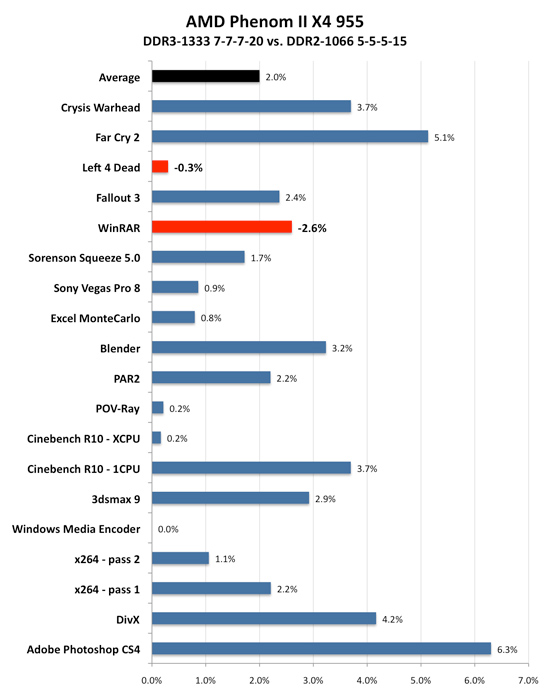AMD's Phenom II X4 955 Black Edition
by Anand Lal Shimpi on April 23, 2009 12:00 AM EST- Posted in
- CPUs
The Move to DDR3: You Can Do It
The Phenom II 955 and 945 support both DDR3 and DDR2 memory. Just a couple of months ago you could save a good amount of money by going with DDR2 over DDR3, but these days the price difference is negligible.
A good pair of 2GB DDR2-1066 sticks will set you back around $57 while a pair of 2GB DDR3-1333 modules will sell for around $60. The problem is that faster DDR3 modules usually have higher latencies associated with them. The table below shows the CAS latency of these modules in ns:
| Memory | DDR2-800 | DDR2-1066 | DDR3-1066 | DDR3-1333 | DDR3-1600 |
| Data Rate | 800MHz | 1066MHz | 1066MHz | 1333MHz | 1600MHz |
| CAS Latency | 4 | 5 | 5 | 7 | 9 |
| CAS Latency in ns | 5 ns | 4.69 ns | 4.69 ns | 5.25 ns | 5.63 ns |
From a latency perspective, DDR2 or DDR3-1066 at CL5 is your best bet. However there is a benefit from having more bandwidth; DDR3-1333 delivers 25% more bandwidth but typical DDR3-1333 modules run at CL7 which translates into 12% higher CAS latency than CL5 at 1066.
The chart below shows the performance improvement from running DDR3-1333 (7-7-7-20) vs. DDR2-1066 (5-5-5-15) on the Phenom II X4 955:

In all but two cases the improved bandwidth, but higher latency DDR3-1333 was faster - but the average performance improvement was only 2%. Some applications managed to see a 5 - 6% increase in performance but overall don’t sweat the difference.
Obviously DDR3 is going to do you more good in the long run so it’s what I’d recommend you stick to if you are building a new system. It’s lasted us a long time and we’ve enjoyed its extreme affordability, but DDR2 is finally on its way out.










65 Comments
View All Comments
poohbear - Thursday, April 23, 2009 - link
hey, is it safe to conclude that since farcry2 shows a 5% increase going from ddr3 1066 to ddr 3 1333 & another 4% going from ddr 3 1333 to ddr 1600, that overall it'd show a 9% increase switching from ddr1066 to ddr1600? that's quite a leap just based on memory!lopri - Thursday, April 23, 2009 - link
UnfortunatelySadly
Unlikely
Disappointing
Useless
Waste
Unpleasant
Painfully
Negligible
--
Luckily
Thankfully
Great
Possibility
Benefit
impressive
Once again
Surprise
Refreshing
Next up (my guess): SSD or Mac
aguilpa1 - Thursday, April 23, 2009 - link
Unfortunately - at 3.2 it can't keep up with 2.66 i7Sadly - AMD needs new architecture
Unlikely - that it will happen soone
Disappointing - results even though quality is improving
Useless - to keep comparing the lates amd to intel
Waste - of article space for these comparisons
Unpleasant - to AMD fans
Painfully - obvious AMD is far behind
Negligible - improvements with new releases
--
Luckily - there are other articles to read
Thankfully - I don't own one of these chips or mobos
Great - bunch of useless data
Possibility - AMD may pull something actually new of these days
Benefit - of better pricing and competition
impressive - how I'm still finding things to write on this
Once again - I am bored by a Tom's article
Surprise - (sorry no surprises here)
Refreshing - my post has come to an end.
Nfarce - Thursday, April 23, 2009 - link
Hahaha! I'm still waiting on the AMD whiners complaining of Anandtech anti-AMD bias every time Intel whips them.Nfarce - Thursday, April 23, 2009 - link
Oh yeah, and the fact that a stock i7 has Turbo Mode is fair game. AMD needs to produce better than this. They own the mid-range GPU market with excellent cards like the HD 4870, but their processor development just - flat - needs - help.Procurion - Thursday, April 23, 2009 - link
Not an issue-I own both AMD and Intel systems but am considering moving up from my 9950BE to the 955 and want to be sure of what I am buying before I spend my money. Some of us aren't as well versed as others in the finer points and that's what I thought the comments section was for.Procurion - Thursday, April 23, 2009 - link
I can understand some of your comments, but according to his data/listed values, the i7 920 is NOT running at stock speed. The frequency he lists is 2.8, NOT 2.66. What's up with that Anand? I can't see where you mention that your test was run with OC'd cpu's but the speed you list for the i7 920 is overclocked? It does skew the results if that is the case.Procurion - Thursday, April 23, 2009 - link
To clarify, the listed speeds for Sysmark, which would make the i7 part look much better than if you had run it at 2.66. To draw the conclusions at the end of your article without noting the difference(if there is one and it's not a typo) or justifying your conclusion with proper references of performance in 50% of your published tests is confusing to say the least. Can you clarify?Spacecomber - Thursday, April 23, 2009 - link
I'm guessing that he is showing the processor's actual speed during the test. The 2.8GHz speed likely is due to the i7's native ability to overclock itself via Turbo Mode (see page 4 of the article). In other words, the i7-920 dynamically has an actual clock speed up to 2.93GHz, depending on the application(s) running.Anand Lal Shimpi - Thursday, April 23, 2009 - link
woops, sorry for the confusion there, the i7-920 ran at its stock speed of 2.66GHz but Turbo Mode was enabled so it'll run as fast as 2.8GHz when more than one core is active.Take care,
Anand